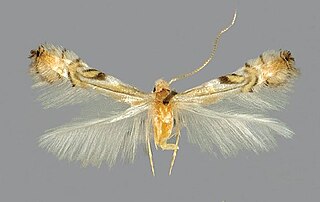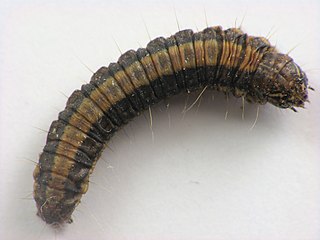Related Research Articles
Heliangara is a genus of moths in the family Gelechiidae.
Imma is a large genus of moths in the obtectomeran "micromoth" family Immidae. This is the type genus of its family. They are widespread in the tropics, with most species occurring between the Himalayas and the Oceanian region; the genus is furthermore plentiful in the Neotropics, but not very diverse in the Afrotropics.

Cosmopterix is a large genus of moth in the family Cosmopterigidae.

The Autostichinae are a subfamily of moths in the superfamily Gelechioidea. Like their relatives therein, their exact relationships are not yet very well resolved. The present lineage was often included in the concealer moth family (Oecophoridae), but alternatively it is united with the Symmocidae sensu stricto to form an expanded family Autostichidae.

Phyllocnistis is a genus of moths in the family Gracillariidae.

The Epipaschiinae are a subfamily of snout moths. More than 720 species are known today, which are found mainly in the tropics and subtropics. Some occur in temperate regions, but the subfamily is apparently completely absent from Europe, at least as native species. A few Epipaschiinae are crop pests that may occasionally become economically significant.

Xyloryctidae is a family of moths contained within the superfamily Gelechioidea described by Edward Meyrick in 1890. Most genera are found in the Indo-Australian region. While many of these moths are tiny, some members of the family grow to a wingspan of up to 66 mm, making them giants among the micromoths.
Dichomeris cymotrocha is a species of moth in the family Gelechiidae. It was described by Edward Meyrick in 1913. It is found in South Africa.
Heliangara ericydes is a moth in the family Autostichidae. It was described by Edward Meyrick in 1916. It is found in Sri Lanka.
Lecithocera carpaea is a moth in the family Lecithoceridae. It was described by Edward Meyrick in 1906. It is found in Sri Lanka.
Lecithocera paroena is a moth in the family Lecithoceridae. It was described by Edward Meyrick in 1906. It is found in Sri Lanka.
Eutorna leptographa is a moth in the family Depressariidae. It was described by Edward Meyrick in 1906. It is found in Australia, where it has been recorded from Tasmania.
Imma chlorosphena is a moth in the family Immidae. It was described by Edward Meyrick in 1906. It is found in Sri Lanka.
Imma cyclostoma is a moth in the family Immidae. It was described by Edward Meyrick in 1906. It is found in Assam in India and Tanintharyi Region of Myanmar.
Imma hectaea is a moth in the family Immidae. It was described by Edward Meyrick in 1906. It is found on Borneo.
Imma melotoma is a moth in the family Immidae. It was described by Edward Meyrick in 1906. It is found in Sikkim, India.
Imma nephelastra is a moth in the family Immidae. It was described by Edward Meyrick in 1906. It is found on Borneo.
Imma otoptera is a moth in the family Immidae. It was described by Edward Meyrick in 1906. It is found on Borneo.
Imma thyriditis is a moth in the family Immidae. It was described by Edward Meyrick in 1906. It is found on the Solomon Islands.
Imma trichinota is a moth in the family Immidae. It was described by Edward Meyrick in 1906. It is found on Sulawesi and Bali.
References
- ↑ Savela, Markku, ed. (December 2, 2013). "Heliangara lampetis Meyrick, 1906". Lepidoptera and Some Other Life Forms. Retrieved August 31, 2020.
- ↑ Journal of the Bombay Natural History Society. 17 (1): 147.
 This article incorporates text from this source, which is in the public domain .
This article incorporates text from this source, which is in the public domain .